++++
Welcome back to my collection of rabbitholes, dug while researching my forthcoming book. Patternalia decodes the cultural histories of graphic patterns across the globe, revealing how many things a simple pattern can mean across cultures, disciplines, and contexts—a topic that required considerable bushwhacking across established library categories. While burrowing deep into plaid (whose history is so nostalgia-soaked, it’s almost wholly invented) and polka dots (a remnant of an 1840s European dance craze, but also a sign of sizzling supernatural energy in Bushmen art, and a globally popular prison tattoo) I amassed loads of books that proved both legit resources and extraordinary procrastination-fodder. The Literary History of Wallpaper? Gimme, gimme! Pattern poetry? What on earth could that be? I became besotted with medieval heraldry, with number symbolism, with camouflage. In writing or any creative work, rabbit-holing comes with the territory. Searching methodically for surprises is my paradoxical business.
Today’s rabbit-hole lands us smack in a Victorian-era barber-shop. While searching to learn why barber’s poles are striped I found a book so curious, so crumbling, it came encased in a sturdy library box like an exoskeleton: History of Signboards From the Earliest Times to the Present Day, first published in 1866.

History of Signboards by Jacob Larwood and John Camden Hotten
Co-authors Jacob Larwood and John Camden Hotten can be fairly described as graphic design flâneurs. They zigzagged across Victorian London, cataloguing and parsing eye-catching street signage wherever they found it. They ranged from commonplace imagery (like the three golden balls traditionally symbolizing a pawnbroker) to idiosyncratic signage, favoring pubs (no doubt a convenient alibi for their thirsty “research”). The book reads like a proto-Tumblr: a magpie collection of images, deliciously curated and captioned with local lore, literary references, contemporary in-jokes.
(Indeed, if anyone’s résumés could prepare them for such quirky work, these gents came well-qualified to the task. Hotten authored a dictionary “of modern slang, cant, and vulgar words,” and edited and authored zillions of erudite forerunners of today’s “listicles”—for instance, Sarcastic Notes of the Long Parliament (1863). Hotten founded a publishing business that would become Chatto & Windus, publishing humorous, slightly lewd works by Mark Twain, Walt Whitman, and Ambrose Bierce, and including the erotic comic opera that screams for a modern restaging, Lady Bumtickler’s Revels. Larwood favored dishy listicles himself, penning such works independently as Humor of the Law and The Book of Clerical Anecdotes.)
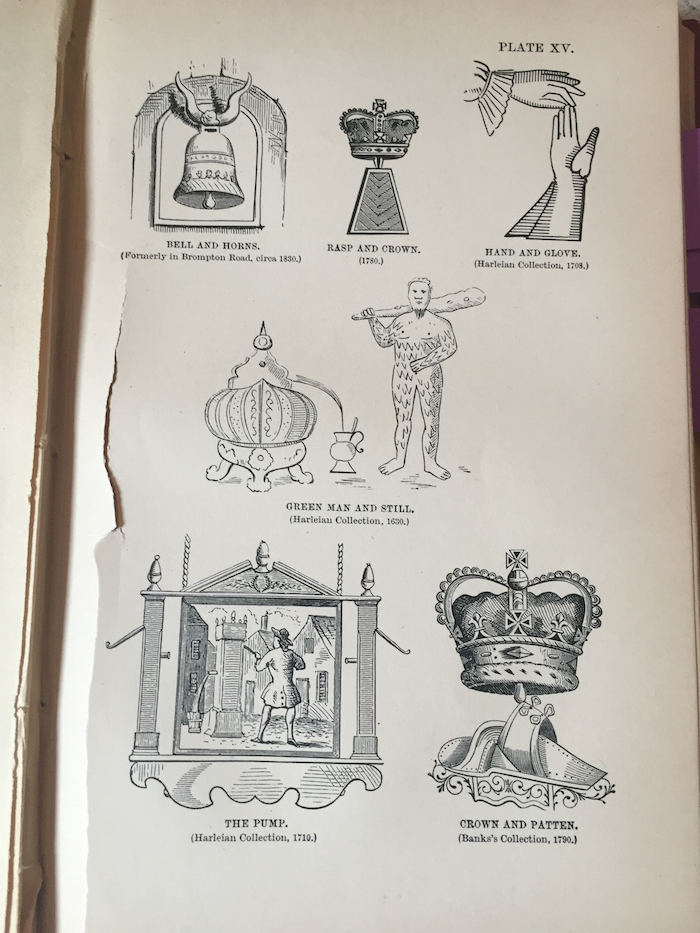
From History of Signboards by Jacob Larwood and John Camden Hotten
Barber's poles may be one of the most enduring and recognizable signs still in use. So why are they striped, you ask? History of Signboards has the answer ready:
The BARBER'S POLE … dates from the time that barber’s practiced phlebotomy: the patient undergoing this operation had to grasp the pole in order to make the blood flow more freely. … As the pole was of course liable to be stained with blood, it was painted red; when not in use, barbers were in the habit of suspending it outside the door with the white linen swathing-bands twisted round it; this, in latter times, gave rise to the pole being painted red and white …
But Larwood and Hotten don’t truck in mere unadorned facts. They regale us with a litany of disgusting signs advertising the early barber’s service menu of hair-cutting, bloodletting, and tooth extraction. We also get sketches of barbers’ foibles, especially loquaciousness, and a round-up of their wittiest signs across the continent. (This post of mine from Print gets into some detail.)
In a funny way, History of Signboards itself feels like a humming, lively barber’s shop, a locus where the A-plot – getting your haircut, or understanding the pictorial language of signboards—is merely the excuse for the B-plot: the supremely enjoyable distraction of tales-swapping. It’s also surprising how deeply one can plunge into what seems like a straightforward visual language. Yes, pictorial signboards helped the illiterate shop: so, for instance, shears denoted a tailor. But like any good branding campaign, what you’re actually selling is not just the product or service (the A-plot); you’re also selling some ineffable differentiation from competitors (the B-plot). So many of the businesses whose signboards the book chronicles are intimate fixtures of their customers’ daily lives. The sign itself vanishes, merges with a whole constellation of comforting signifiers: the peculiar creak of the door, the cast of sunlight on the wares, the cadence of the shopkeep’s voice. For the regulars, a particular signboard embodies the whole experience; its picture, however flat, becomes layered and charged with meaning.
Take the enigmatic signboards featuring unicorns—what could they possibly sell? “The qualities attributed to the UNICORN caused this animal to be used as a sign both by chemists and goldsmiths,” write Larwood and Hotten. Hunters could lure a unicorn with a “handsome young virgin,” which might tempt the animal to lay its head in the pure spot that is a virgin’s lap. “It is reported that the unicorn’s horn sweats when it comes in the presence of poison,” wrote the thirteenth-century scholar Albertus Magnus—and clearly apothecaries might benefit from an association with poison-free medicine. “Whatever it was that passed for the unicorn’s horn (probably the horn of the narwhal) it was sold at an immense price,” Larwood and Hotten continue, enumerating more and more outlandish sums demanded for this prized stuff (20 shillings per ounce, according to a 1531 customs book), until “the great value set upon unicorn horn caused the goldsmith to adopt this animal as their sign.” But, of course!
Other iconic British characters held commercial associations that might surprise modern viewers. Consider the “Man in the Moon,” a frequent sign above Victorian tobacconists’ shops and pubs. Larwood and Hotten trace the Man to the biblical book of Numbers 15:32: “'And while the children of Israel were in the wilderness, they found a man that gathered sticks on the Sabbath day.' Not content with having him stoned for this desecration of the day, the legend transferred him to the moon.” Traveling through the centuries, the Man’s sticks transmogrify into a bushel of thorns, supplemented occasionally by a lantern and dog. He wanders across literature, from Shakespeare’s Tempest to Dante’s Inferno; he gets conflated with Cain’s unwelcome offering to God of thorns; eventually he mellows into a jolly, unrepentant type lauded in songs. “Our Man in the Moon drinks Claret / With powder-beef, turnip and carrot / If he doth so, why should not you / Drink until the sky turns blue”—this according to the Roxburghe Ballads quoted by Larwood and Hotten. Perhaps his bundle of sticks catches fire, because his insouciant face later appears widely on tobacconists’ signage and papers imprinted with the motto: “Who’ll smoake with ye Man in ye Moon?”
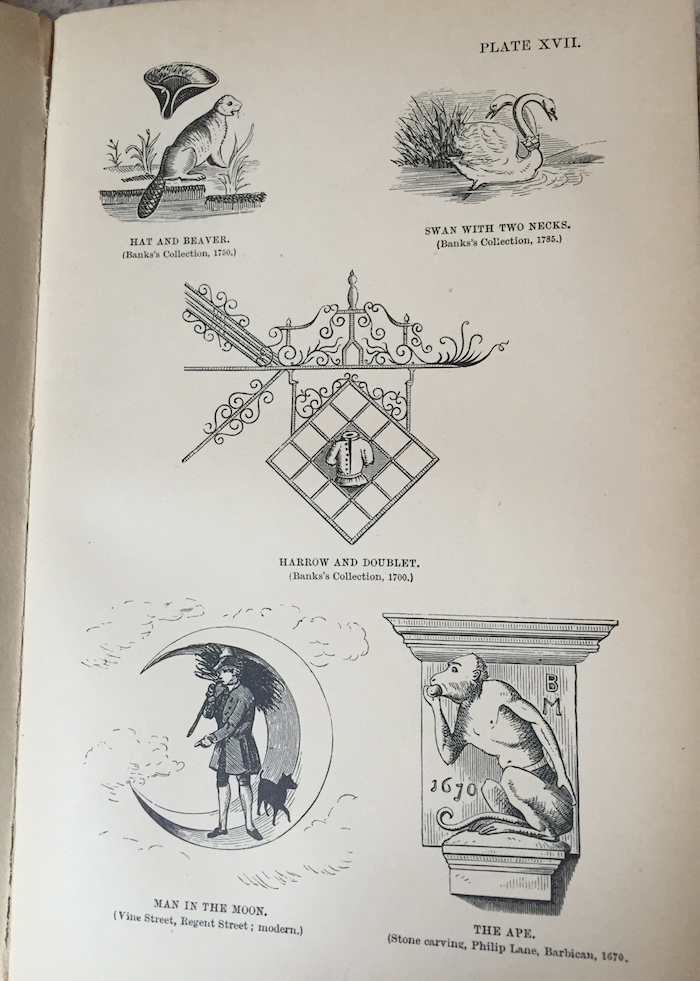
From History of Signboards by Jacob Larwood and John Camden Hotten. The Man on the Moon is pictured in the lower left.
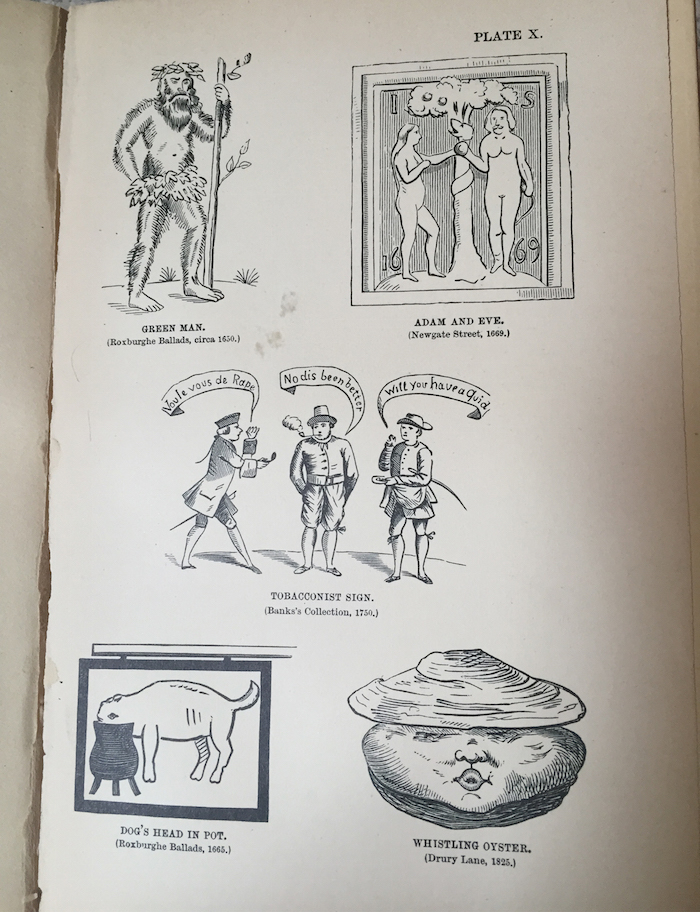
From History of Signboards by Jacob Larwood and John Camden Hotten. Another common trope for tobacconists’ signs is pictured at center.
“Drinking vessels are very appropriate ale-house signs,” write Larwood and Hotten of the antiquated BLACK JACK featured on many pub signs—not that many of us moderns would recognize it on sight. A black jack “was a leather bottle, sometimes lined with sliver or other metal,” Larwood and Hotten explain, “ornamented with little silver bells ‘to ring peales of drunkenness,’ in which case it was called a ‘gyngle boy.’”
Of course, pubs then and now are so identical, more and more fantastical signage must be brought to bear to impart some whiff of individuality. How to explain all the “Pig and Whistle” taverns from Macclesfield to Coventry? Some scholars trace this to the Saxon piggen (milking pail, or later a mug for beer) and wassail (to be in good health), others to the “Danish-Saxon … pige-washail, our Ladies’ Salutation” opening the Hail Mary prayer. “The Scotch also claim it as their own,” Larwood and Hotten continue, “pig being a pot or potsherd; whistle, small change; and ‘to go to pigs and whistles’ a free translation of ‘going to pot.’” What exactly is fact and what’s fiction? That’s important—and yet also slightly beside the point. As I illustrate in Patternalia, I’m less interested in nailing the gospel truth as finding the right nonfiction starting point from which explanatory lore spools.
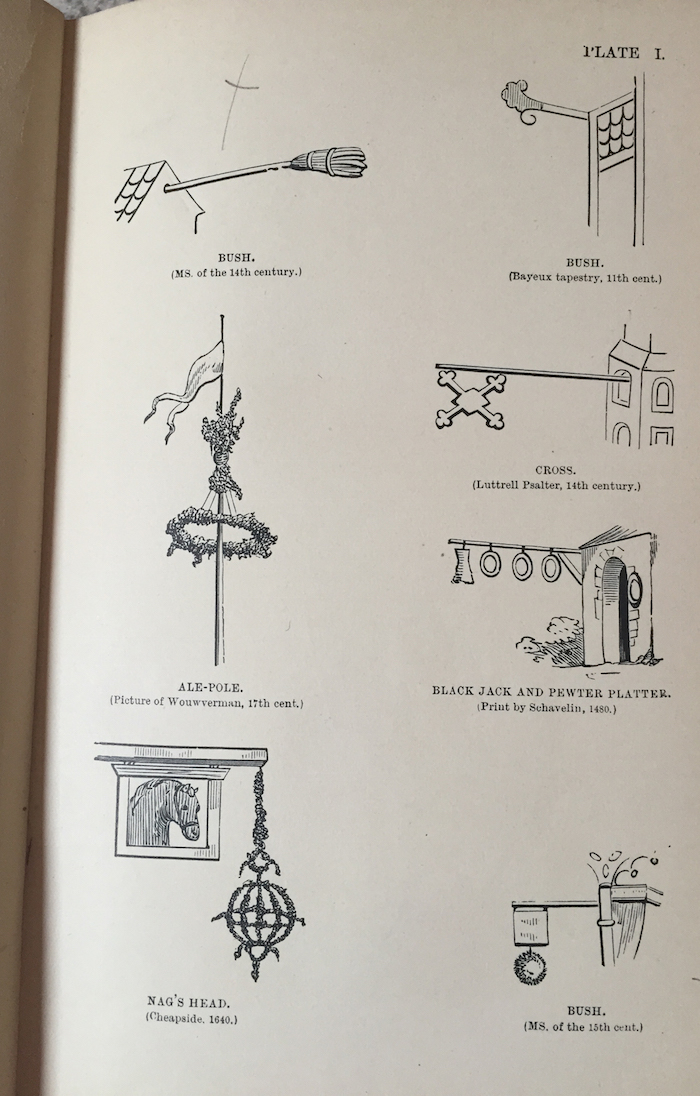 From History of Signboards by Jacob Larwood and John Camden Hotten. Black jack tankards alternate with pewter plates in the middle-right sign.
From History of Signboards by Jacob Larwood and John Camden Hotten. Black jack tankards alternate with pewter plates in the middle-right sign.Perhaps the most intriguing signboards are the ones Hotten and Larwood fail to decode. Either their meaning—now cryptic to us—seemed obvious to them, or they wanted to draw a veil of wordlessness over truly strange pictures. Or maybe they found themselves in the dark, too. Consider the marvel of the GRINDING YOUNG, “a very curious sign at Harold’s Cross, Dublin.” Larwood and Hotten attribute it to an old ballad “Miller’s Maid Grinding Old Men Young” and dutifully describe the bizarre scene: a line of elderly gents hopping into the funnel top of a hand-mill cranked by a young maiden. Issuing from the mill are spry young men, who pair off with similarly juicy young women, “evidently preparing to play the old game over again … a very decided improvement upon the usual way of entering the stage of this world.” Could the GRINDING YOUNG be the most universal marketing promise? Words fail us—but the sign surely tempts us in.
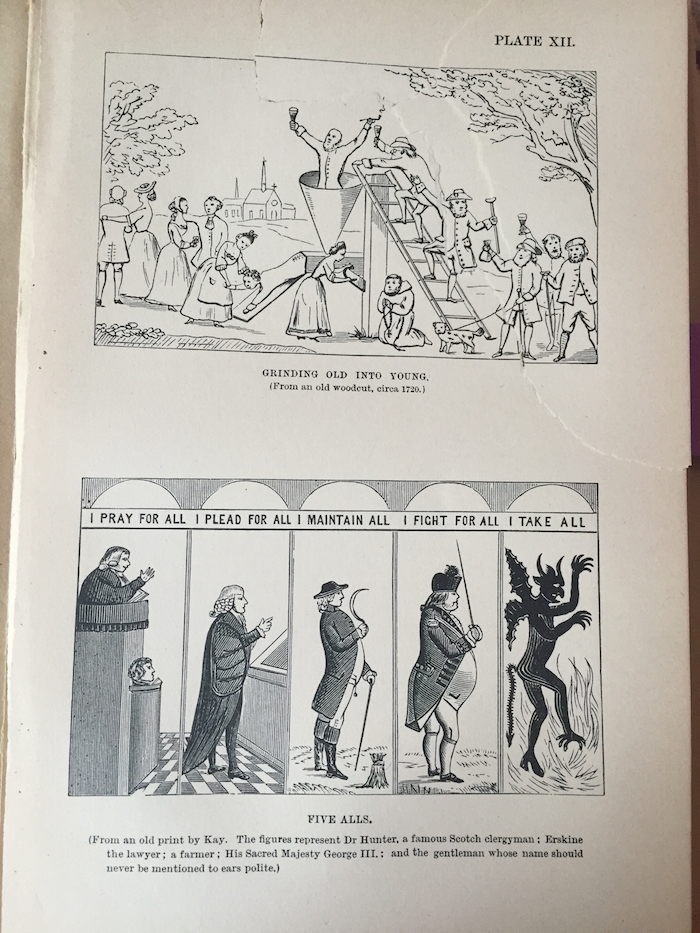
From History of Signboards by Jacob Larwood and John Camden Hotten.
